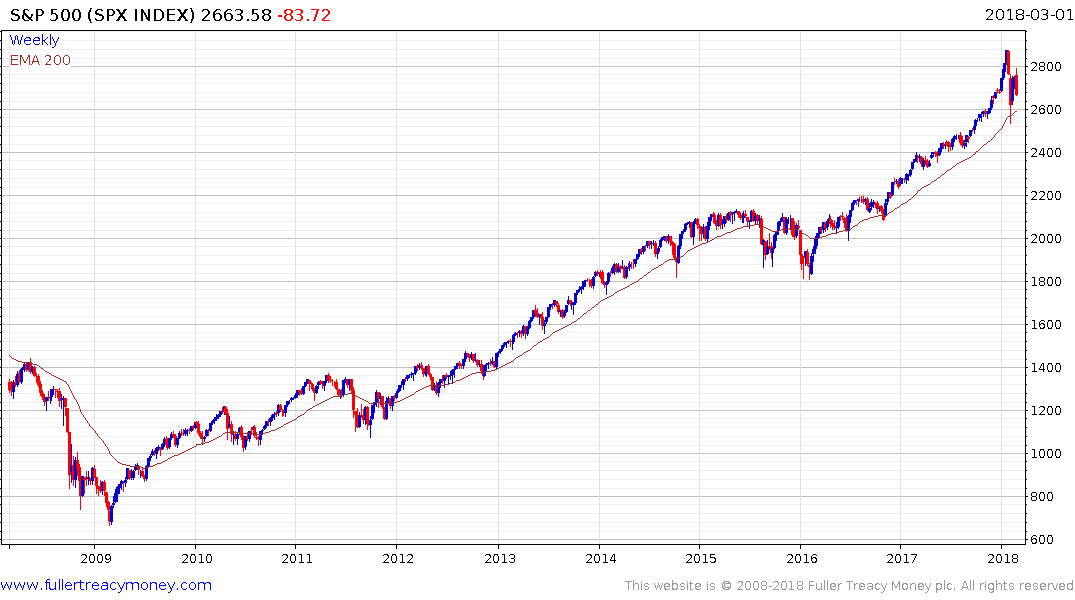"Fickle February"
Thanks to a subscriber for this report by Jeffrey Saut for Raymond James. Here is a section:
One of them, and arguably the smartest strategist on “The Street,” is my friend Tony Dwyer, who writes:
Why bother worrying about a retest? Given our positive fundamental core thesis and 3100 target, many wonder why we bother calling for a retest of the “shock drop” ending the week of 02/09. The answer is simple – when a retest happens, fear it is something more significant causes many to reduce risk, just at the very time history suggests increasing it. In all prior occurrences of such a historic spike in the 10-week rate-of change in volatility as measured by the CBOE Volatility Index (VIX), there was an average bounce of 5.62% (ex-2008 instance) prior to the retesting of the low 30 trading days later. With a gain of 4.89% from our signal highlighted in “Shock drops, pops and flops,” the market is following the script, which means the comfort of the rebound should soon fade, either from fear of Fed, disappointing data, or some combination of the two.
Obviously, opinions vary on the “Street of Dreams,” but that’s what makes a market. We happen to think a full retest of the “selling climax lows” is not going to happen, but then anything can happen in the equity markets. So, what caused yesterday’s Dow Dump (-380 points). Well, we think it was cognitive dissonance, which would be the ability to hold two disparate thoughts at the same time. In the current case it is whether to believe the softening headline economic reports (durable goods, housing, etc.), or the details within those reports that show final sales up 3.3%, domestic final sales better by 4.3%, and private domestic final purchases improving by 4.6%, which suggest the economy is really strong. We continue to think the economy is stronger than a “garlic milkshake!” This morning the S&P 500 futures are off about 7-points as we write at 5:12 a.m. as the Street awaits Fed head Powell’s part 2 testimony to lawmakers. Clearly, Wall Street is currently of the belief that Jay Powell is more hawkish than his predecessors. Surely time will tell; but, until he demonstrates a more dovish disposition, the perception will be the new Fed Chair is a hawk.
Here is a link to the full report.
Ranging appears to be the most amenable course of action for the market following the sharp drawdown in February that resulted in a 10% pullback. February was the first month in 15 where the S&P500 recorded a negative return. Since that was the longest run of consecutive positive monthly returns in decades it is reasonable that this inconsistency represents at least a pause for markets.

The S&P500 pulled back sharply to the region of the trend mean, bounced and now the most pressing question is where support is likely to be found. Whether the low is testing or support is found above it is largely beside the point so long as a move is not sustained below it.
There have been occasions in the course of the medium-term bull market since 2009 when the Index traded below the trend mean for months at a time. The most recent occasion was in 2015 and early 2016 when high yield spreads were quite a bit higher than they are now.
On this occasion, high yield spreads have not moved but interest rates are higher and the market is still digesting whether the new Fed chair is willing to ride to the rescue in times of stress. An 11% pull back from peak to trough is obviously not sufficiently stressful to this Fed chair.
At the same time earnings are positive and companies are buying back shares at a prodigious rate which supports prices. The most likely scenario is still for ranging but this is an important time to monitor the consistency of trends.
Back to top

